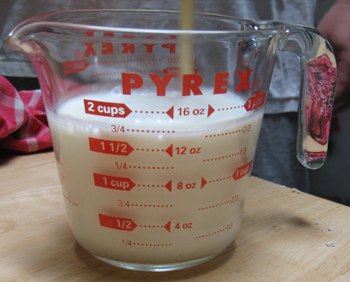
This Friday we’re reporting on one of the experiments we were looking forward to last Friday, the one in which milk is curdled. (We’ll report on our experimental attempts to dissolve an avocado next Friday.)
We started with a little over a cup and a half of whole milk, on the cold side (since it was in the fridge until we were ready to start experimenting). Since we don’t have glass stirring rods at home, we decided to use a plastic chopstick to do the stirring.
As a control, before we started adding lemon juice, we put the chopstick in the cup of milk. The presence of the chopstick had no observable effect on the milk. We stirred the milk with the chopstick for awhile. This kicked up some bubbles in the milk, but when we stopped stirring and let the milk sit for a few moments, the bubbles went away.
We concluded that the chopstick itself doesn’t curdle milk.
Then it was time to bring on the lemon juice.
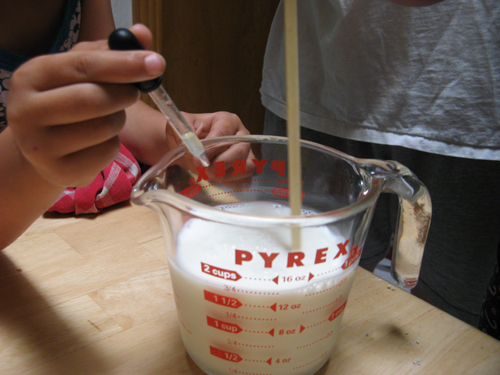
We started out adding the lemon juice (full strength, fresh squeezed, at room temperature) dropwise. We weren’t sure how much lemon juice it would take to start to produce curdling that was visible to the naked eye. Would it take just a few drops?
No.
It turns out, by the way, that it is easier to teach a child how to control the pressure on the bulb of an eyedropper well enough to release a single drop of liquid at a time than it is to teach that same child not to turn the eyedropper upside down after delivering the drop. (That lets liquid into the dropper bulb, you see. It’s probably less of a big deal with lemon juice than with various other liquids, but contamination is contamination.)
Amid all the drop-drop-dropping of drops of lemon juice into the milk, there was also stirring.
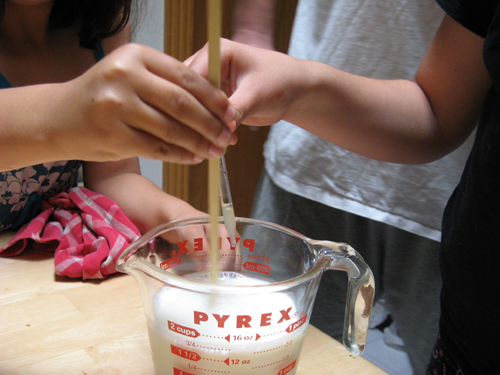
After three or four eyedroppers of dropwise lemon juice addition with no visible change in the milk, we got kind of impatient. The next few eyedroppers’ worth of lemon juice were added all at once, with mighty squeezes. Then, finally, we poured the remaining lemon juice (approximately 25 mL) into the milk. With the juice of a whole lemon in the 1.6 cups of milk, we finally saw what we had been waiting for.
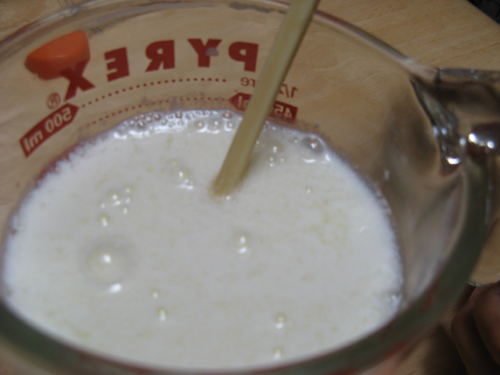
Curdling! The curds were not large, and once they started visibly forming, the amount of curdling seemed to increase in a hurry.
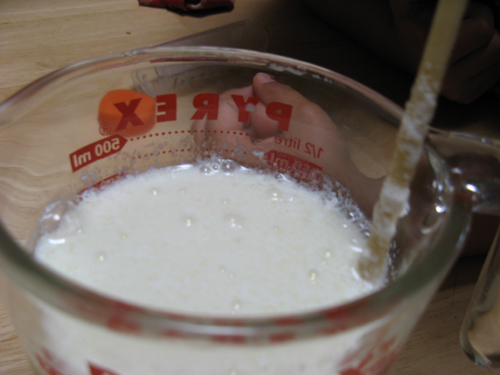
After we stirred for awhile and the amount of curdling reached a point where it didn’t seem to be increasing any more, we decided it was ready to collect the curds. We lined a strainer with a few layers of cheesecloth (wetted down with tap water), put it over another Pyrex measuring cup, and poured our curdled milk into the lined strainer.

The cheesecloth caught the curds (at least, the ones that weren’t really really tiny). The liquid that dripped out the bottom of the lined strainer (presumptively, the whey) looked a lot different from the milk we started out with.
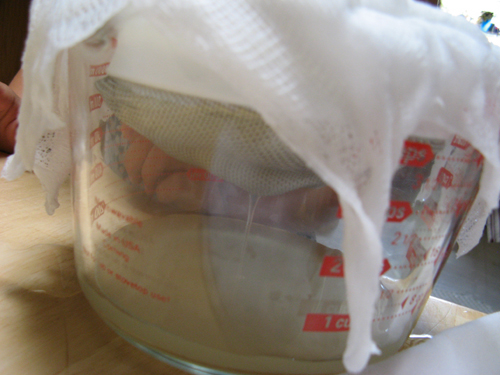
It didn’t look quite like water, but it was much clearer than the milk, and almost colorless. As the filtration was underway, we chatted a little about why milk might be white and opaque (rather than see-through). We also discovered that the sprogs tire easily of jokes in the “No way!”/”Whey!” oeuvre.

After a light snack of cottage cheese (with a noticeable hint of lemon flavor), we started to wonder if we’d successfully curdled everything that could be curdled in the recovered whey.
So, we squeezed another lemon and added the juice to the whey.
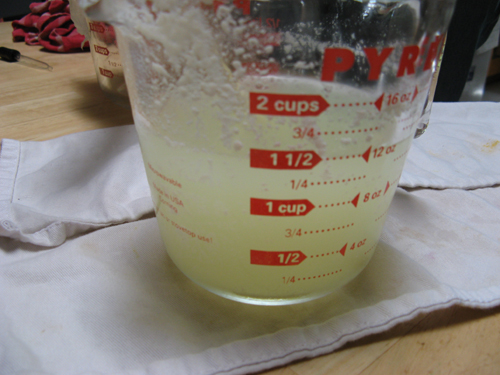
The whey looked pretty much the same after the lemon juice was added as it did before. There was no visible curdling upon this addition, even with vigorous stirring. (“Isn’t that curdling there?” I hear you ask. Maybe, but we think that was what got through the cheesecloth-lined strainer, not some further reaction of whey and lemon juice.)
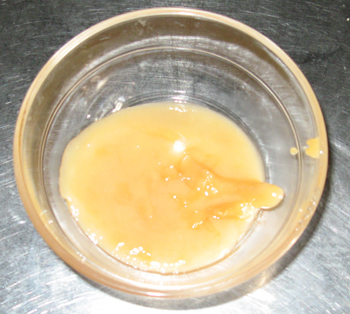
Since we were kind of reaching the limits of our collective attention span, Dr. Free-Ride’s better half decided that whatever reaction we might see between the whey and the lemon juice might be helped along by heat.
The whey and lemon juice mixture was transferred to a saucepan and heated on the stove (near a boil) for … a while. We pretty much all got absorbed in doing other stuff, so I can’t tell you precisely how long it was there. What remained at the end of the heating is the scary looking substance pictured here.
Dr. Free-Ride’s better half reports that it was grainy, with a very sour and salty flavor to it. Not recommended for human ingestion.
We had fun. We’re going to follow up the experimentation by doing a little reading on:
- What kind of liquid milk is. (It’s not a solution but rather a colloidal suspension. Explaining the difference to the sprogs should be interesting.)
- What component of the milk is reacting with the lemon juice, what’s going on in that reaction, and why the result is a solid.
- What kind of a liquid whey is.
We may also look into other interesting reactions between milk and household substances.
Next Friday: the avocado results, and the questions they raise.

Here’s one I remember from my own junior-high science-geek days:
Mom had heartburn.
Mom chewed up a couple of milk of magnesia antacid tablets.
Dad came home from work with a bag of one of Mom’s favorite treats — fresh cherries.
Despite the heartburn and the minted-chalk aftertaste of milk of magnesia, Mom couldn’t resist eating some cherries.
Mom looked in the mirror a few minutes later and found nasty bluish-black powdery stuff all over her lips.
I did a quick experiment (crushed a milk of magnesia tab in water, then added a squashed cherry.) Sure enough — blackish precipitate. Then I tried it with orange juice. I seem to recall that the precipitate was greenish.
Might be a fun one to try!
Growing up I inherited an old Boy Scout Field Manual (not handbook).
It had a lot of interesting cooking ideas for out in the boonies, and one was ‘Lemon Pudding.’
The recipe for it is the same recipe you used for your experiment, i.e. milk and lemon juice.
I did not ever quite find the nerve to try it.
I did cook more than one egg on a spit, however.
Julie, the same thing happens to me if I take Pepto Bismol right before going to sleep. Except it’s on my tongue instead of my lips. I wonder if it is the same kind of reaction, since they’re slightly different medications but with similar uses.
Do you have Harold McGee’s wonderful On Food and Cooking? It’s full of detailed information about the structure and chemistry of the things we eat.
What sort of house doesn’t have platinum stirring rods? Shame on the Free-Rides! Shame on them!
An interesting variation is pressing the curds with a weight (for about 30 min.) and presto ! You’ve made paneer. Paneer is an indian cheese, and as a vegetarian I’m pretty fond of it. After pressing, cut up the paneer and deep-fry until it browns a little. Great in curries.
http://en.wikipedia.org/wiki/Paneer
Dang. Belgian Veggie scooped me – I learned that from one of PharmGirl’s Mahdur Jaffrey cookbooks.
We’ll report on our experimental attempts to dissolve an avocado next Friday.
Embargoed, eh? Well, I am a freelance writer and would like to apply for advance copies of this and future peer-reviewed reports from the Journal of Sprog Science.
Now I want to do this. I’d always looked at it as more of a cottage cheese recipe than a science experiment. My kids would prefer an experiment to a cooking lesson!
But did a spider come along while you were eating your curds and whey?
Belgian Veggie:
Mmmm, paneer. Saag paneer is great stuff too, even if it looks like baby food.
Janet:
In addition to the recommendation of the McGee book, I would also suggest Cookwise by Shirley Corriher, How to Read a French Fry by Russ Parsons, Kitchen Science by Howard Hillman, I’m Just Here for the Food by Alton Brown, and the What Einstein Said To His Cook books. All great books for the kitchen geek in training.
Food Science – what fun! Guelph University has a great dairy website if you want more information and pictures to show the Sprogs:
http://www.foodsci.uoguelph.ca/dairyedu/home.html
Funnily enough, buttermilk doesn’t exist in England (or at least, we can’t get them at the grocery store) so when I make pancakes that call for buttermilk, I mix some lemon juice with milk and let it sit, and then use it in place of buttermilk. I don’t remember who told me that it works, but it does, although I’m not sure if the result is really buttermilk or some combination of soured milk + cheese + ?!